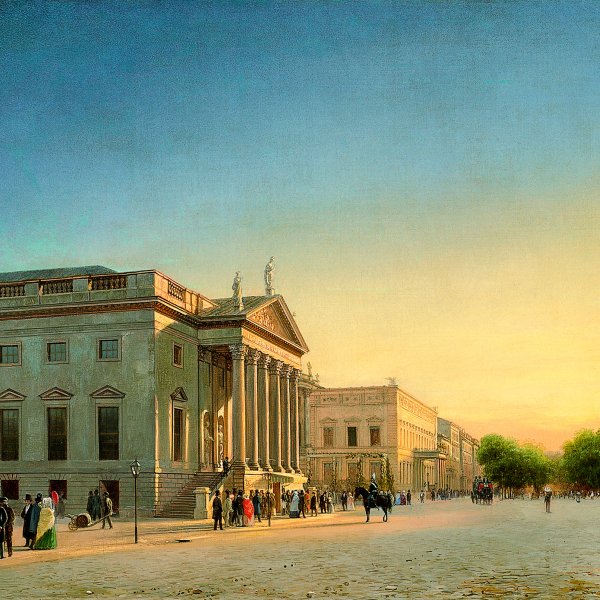Eduard Gaertner
Berlín, 1801 -Zechlin, 1877
Gaertner's earliest training dates to 1814 when he started his apprenticeship at the Königliche Porzellan-Manufaktur (Royal Porcelain Factory) in Berlin. His training included perspectival drawing, which he made use of in painting models of views and decorative patterns onto porcelain. Economic difficulties at the porcelain factory induced him to join the workshop of the famous theatre set designer Carl Gropius, a friend of Schinkel's, in 1822. It was Gropius who supplied Gaertner with his first royal commissions. For Frederick William III, he reproduced rooms of the royal building in Berlin. Between 1825 and 1828 he travelled to Paris to further his artistic education. The work he completed in the French capital shows the influence of English watercolorists but it also reveals his already mature and autonomous artistic personality. During the 1830s, Gaertner was primarily involved in painting views of Berlin. From 1837 to 1839, he travelled repeatedly to Moscow and to St. Petersburg in the years when the Russian and Prussian courts were particularly close, in part because the Tsar's wife, Alexandra Fedorovna, was the daughter of Frederick William III. The watercolours and oil paintings he made in St. Petersburg and in Moscow are among the most picturesque 19th-century views of these two Russian cities. Following the death of his principal supporter and protector, Frederick William III, Gaertner travelled in parts of Germany, in what is now the Czech Republic, in Poland, as well as in Pomerania and eastern Prussia. In these regions he discovered new subjects to paint so that, from 1840 onward, he expanded his repertoire with famous medieval building and landscapes. Meanwhile, his painting had become more immediate while the lighting created more emotional or dramatic atmospheres. Gaertner was unable to adapt to the changing tastes in the 1860s, and around 1870 he retired to Zechlin, in the region of Brandenburg, north of Berlin. He died there in 1877.
Gaertner was among the leading 19th-century Berlin architectural painters. His careful observation of detail, sensitivity to life and to the social events of his day, and the veiled transparency of his brushwork all give his paintings an analytical clarity. This documentary realism, a salient trait of art in Berlin, would find its most complete expression in the work of Adolph Menzel.
Sybille Gramlich
Gaertner was among the leading 19th-century Berlin architectural painters. His careful observation of detail, sensitivity to life and to the social events of his day, and the veiled transparency of his brushwork all give his paintings an analytical clarity. This documentary realism, a salient trait of art in Berlin, would find its most complete expression in the work of Adolph Menzel.
Sybille Gramlich




